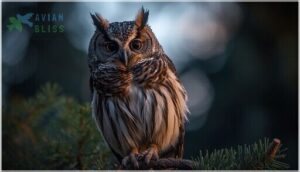This site is supported by our readers. We may earn a commission, at no cost to you, if you purchase through links.

You won’t spot this owl the way you spot most others. The flammulated owl hunts under cover of darkness with eyes as black as the night around it.
This tiny bird is no bigger than your hand, yet it produces a call so low and booming you’d swear it came from something three times its size. Found in the old pine forests of western North America, this insect-eating specialist lives a life that sets it apart from nearly every other owl on the continent.
Its flame-patterned feathers help it vanish against tree bark during the day. Understanding this secretive bird means learning to recognize what makes it different from the owls you already know.
Table Of Contents
- Key Takeaways
- What is a Flammulated Owl?
- Physical Appearance and Identification
- Habitat and Geographic Range
- Behavior, Diet, and Nesting Habits
- Conservation Status and Threats
- Frequently Asked Questions (FAQs)
- What does a flammulated owl look like?
- What is a flammulated owl?
- What is flammeolus owl?
- What do flammulated owls eat?
- Where do flammulated owls nest?
- Do owls fight Bluebirds?
- What is the meaning of Flammulated Owl?
- What are some fun facts about Flammulated Owls?
- What is the difference between a screech owl and a Flammulated Owl?
- How tall is a Flammulated Owl?
- Conclusion
Key Takeaways
- The flammulated owl is a tiny insect-eating owl with dark eyes and flame-patterned feathers that lives in old-growth pine forests of western North America.
- This owl relies almost entirely on insects like moths and beetles for food, making it unique among North American owls except for the elf owl.
- Flammulated owls migrate up to 3,500 kilometers between breeding grounds in the western mountains and wintering sites in southern Mexico and Guatemala.
- The species faces serious threats from habitat loss and climate change, with projections showing an 85% range decline by 2090 if current trends continue.
What is a Flammulated Owl?
The Flammulated Owl is a tiny nocturnal hunter that you’ll find in the mountain forests of western North America. This six-inch owl feeds almost entirely on insects and sports dark eyes that set it apart from its screech-owl cousins.
Let’s look at its scientific background, key traits, and how you can tell it apart from similar species.
Scientific Name and Classification
You’ll find the flammulated owl listed as Psiloscops flammeolus in scientific records. This owl species belongs to the order Strigiformes and family Strigidae. The genus name Psiloscops means “naked Scops” in Greek. The species name flammeolus refers to flame-like markings on its feathers. Johann Jakob Kaup first described this species in 1852. No subspecies exist, making it monotypic.
These owls are a neotropical species found in the New World.
Defining Characteristics
You can identify a flammulated owl by its compact size and dark eyes. This small owl measures 15-17 cm long with a wingspan of 36-42 cm. You’ll notice short ear tufts that usually stay flat against its head. The bird shows two color morphs: gray or reddish-brown. Look for flame-like rufous streaks on the shoulders and back.
As a primarily insectivorous species, their diet consists mainly of insects. Its soft, low-pitched hoots sound surprisingly deep for such a tiny owl.
Comparison to Similar Owl Species
You can distinguish the flammulated owl from similar species through key field marks. Western Screech-Owls are larger with yellow eyes and prominent ear tufts. Northern Pygmy-Owls match in size but display yellow eyes and spotted crowns. Boreal Owls lack ear tufts entirely. Elf Owls measure smaller at 13-14 cm.
The flammulated owl’s dark eyes separate it from most screech-owl comparisons in any owl identification guide.
Physical Appearance and Identification
You can identify a Flammulated Owl by its tiny size and unique features. This owl is one of the smallest in North America, with short ear tufts and dark eyes.
Let’s look at the key physical traits that help you spot this elusive bird in the field.
Size and Measurements
You’ll notice the Flammulated Owl is tiny—just 15 to 17 centimeters long and weighing 43 to 63 grams. Its wingspan stretches 36 to 41 centimeters. Sexual dimorphism shows females are heavier than males by 10 to 15 grams.
Juvenile growth reaches adult size around 30 to 35 days. These measurement techniques help you understand the owl’s physical description and size variation.
Color Morphs and Markings
The Flammulated Owl comes in two primary color morphs: gray and red. Gray birds dominate northern regions, while red morphs appear more in southern areas. Regional plumage variations help with adaptive camouflage against local tree bark. Juvenile markings start pale but develop adult patterns by two weeks.
- Flame-like rusty feathers streak across shoulders and scapulars
- Cryptic coloration with vermiculated patterns throughout upperparts
- Buffy-gray mottled bars crossing wing feathers
- White collar spots encircling the neck base
Distinctive Field Marks
When you’re trying to confirm a Flammulated Owl identification in the field, look for five key traits that set it apart from other small owls.
| Field Mark | Description |
|---|---|
| Dark eyes | The only small Canadian owl with dark brown eyes instead of yellow |
| Short tufts | Small ear tufts often held flat against the head |
| Flame tips | Orange-tipped scapular feathers creating a rusty shoulder streak |
| Facial disk | Incomplete disk pattern ending at the moustache region |
| Unfeathered toes | Completely bare toes unlike other North American owls |
These Flammulated Owl physical characteristics work together for reliable identification.
Habitat and Geographic Range
You’ll find Flammulated Owls in the mountain forests of western North America. These small owls don’t just pick any woodland—they’re choosy about where they set up their territories.
Let’s look at the specific forest types and regions where you can spot these birds.
Preferred Forest Environments
You’ll find Flammulated Owl habitat in old-growth forests with trees over 100 years old. These montane pine forests feature ponderosa pine forests mixed with Douglas-fir.
The owls prefer elevation preferences between 850 and 1,150 meters on ridges and upper slopes. Forest structure matters too. Look for open canopies at 40-50% closure with large well-spaced trees.
Climate preferences lean toward cooler semi-arid conditions in these pine forests.
Breeding and Wintering Range
You can track this owl’s breeding range from southern British Columbia through the Rocky Mountains into central Mexico. Males show strong breeding fidelity and return to the same territories each year.
Migration routes stretch over 3,400 kilometers to wintering grounds in southern Mexico and Guatemala. Range shifts are moving populations northward and upward as habitat connectivity faces climate pressure.
Elevation and Regional Distribution
You’ll encounter this species mostly between 6,000 and 10,000 feet in western mountains. Regional populations thrive in Colorado, Idaho, Montana, and Arizona where mature ponderosa pine forests dominate. British Columbia sites usually range from 850 to 1,150 meters elevation.
Density data shows fewer than four singing males per 40 hectares. Climate influence is pushing Flammulated Owl habitat upslope as temperatures rise.
Behavior, Diet, and Nesting Habits
The Flammulated Owl lives a life shaped by darkness and insects. You’ll find these small owls hunting at night with methods that set them apart from other species.
Their behavior shows clear patterns in how they feed, where they nest, and how they travel between seasons.
Nocturnal Hunting and Feeding Behavior
Flammulated Owls hunt only at night, most active right after dark and before dawn. They perch quietly and watch for prey with their sharp eyes.
Then they fly down to catch insects from leaves or the ground. Sometimes they hover to grab moths from branches. These owls don’t use sound to hunt like other owls do.
Insect-Based Diet
You’ll notice that over 95% of this owl’s diet comes from insects and other small creatures like spiders. Moths make up more than half of what they eat, while beetles and crickets account for another 20–30%.
This insect-based diet makes the Flammulated Owl unique among North American owls, matched only by the tiny Elf Owl in prey composition.
Breeding and Nesting Sites
When it comes time to raise young, you’ll find these owls showing strong loyalty to old nest sites. They overwhelmingly choose natural tree cavities—94% select woodpecker holes in dead pine snags rather than artificial nest boxes. Each pair usually lays 2–3 eggs per season in territories they defend year after year.
What makes their nesting noteworthy:
- Fierce home loyalty – Breeding pairs return to the same territory across multiple seasons, creating generational connections to specific forest stands
- Ancient tree dependency – Without old-growth snags and their ready-made cavities, breeding success plummets dramatically
- Selective cavity standards – Heights below 50 feet in open ponderosa pine stands are strongly preferred over other available options
- Vulnerable family planning – Only one brood per year means every nesting attempt carries the weight of annual survival
- Habitat crisis reality – Logging and wildfires have stripped away the standing dead trees these owls desperately need
Migration Patterns
After nesting wraps up, you’ll witness one of the most striking journeys among North American owls. Flammulated Owls undertake true transladitudinal migration, traveling 2,000 to 3,500 km from western breeding grounds to wintering sites in southern Mexico and Guatemala.
Migration timing runs from August through October, with juveniles departing earlier than adults. They follow consistent routes through coniferous stopover habitats, especially the Spanish Peaks corridor, before reaching pine-oak forests for winter.
Conservation Status and Threats
The Flammulated Owl isn’t globally threatened, but its numbers are shrinking. Habitat loss and environmental changes put pressure on this small owl’s survival.
Let’s look at what scientists know about its population and the challenges it faces.
Population Estimates
You might wonder just how many of these tiny owls exist in the wild. Global abundance estimates vary widely due to data limitations. Here’s what researchers have found:
- Partners in Flight estimates about 5,500 breeding individuals worldwide
- Other sources suggest 20,000 to 40,000 total population
- North American breeding population may reach 12,000 birds
- Population trends show a 30–50% decline over time
- Estimation methods rely heavily on habitat modeling and limited surveys
The Flammulated Owl’s conservation status remains uncertain because its nocturnal habits and patchy geographic distribution make accurate counts challenging across its habitat range and migration patterns.
Major Threats and Challenges
If you’ve been following along, you know these owls face steep odds. Habitat loss from logging strips away essential nesting trees, while wildfires burn through breeding grounds at alarming rates.
Climate change threatens to shrink their range by 85% by 2090. Pesticide exposure poisons both the owls and their insect prey.
Climate change and pesticides together threaten the Flammulated Owl’s survival, with range projected to shrink 85% by 2090
Competition for nest cavities and human disturbance add further pressure to their conservation status.
Ongoing Research and Conservation Efforts
Tracking technology like geolocators and Motus towers helps researchers map migration routes across North America. Population genetics studies reveal high dispersal rates between regions.
Habitat restoration projects thin dense forests and use controlled burns to improve nesting sites.
Citizen science programs in Montana engage volunteers to monitor populations.
International cooperation between Canada and the U.S. strengthens Flammulated Owl conservation status through shared data and coordinated management plans.
Frequently Asked Questions (FAQs)
What does a flammulated owl look like?
You’ll spot a tiny owl with dark eyes and short ear tufts.
Its mottled feathers show flame-like rusty streaks on gray or reddish-brown plumage, making flammulated owl identification distinct from similar species.
What is a flammulated owl?
The Flammulated Owl (Psiloscops flammeolus) is a tiny insect-eating owl from western North America. You’ll recognize it by dark eyes, short ear tufts, and flame-like rusty markings on mottled plumage.
What is flammeolus owl?
A single flame-colored species stands alone in owl evolution. Psiloscops flammeolus carries unique traits linking it to the Puerto Rican owl.
This genus history reveals an insectivorous specialist with distinct physical characteristics shaped by forest environments.
What do flammulated owls eat?
You’ll find their diet is almost entirely insects. Moths, beetles, and crickets dominate their meals.
They catch prey mid-air or pluck them from foliage during nocturnal hunts, perfectly adapting their foraging behavior to insect abundance.
Where do flammulated owls nest?
You’ll find these owls nesting in tree cavities, mainly inside dead snags in open ponderosa pine forests.
They prefer large-diameter trees with woodpecker holes at mid-elevation mountain sites across western North America.
Do owls fight Bluebirds?
Yes, they do. Nest site competition between owls and bluebirds can lead to interspecies aggression. Flammulated Owls sometimes evict bluebirds from cavities, taking over active nests. This behavior shows territorial aggressiveness over limited nesting resources.
What is the meaning of Flammulated Owl?
The term comes from the Latin “flammeolus,” meaning flame-colored. You’ll notice those reddish streaks on the bird’s shoulder and back inspired its name. Psiloscops flammeolus stands alone as a monotypic species in its genus.
What are some fun facts about Flammulated Owls?
You’ll spot the Flammulated Owl by its dark eyes and cryptic plumage. This nocturnal hunter relies on camouflage and feather patterns while catching insects at night.
Its unique vocalizations echo through mountain forests during breeding season.
What is the difference between a screech owl and a Flammulated Owl?
Think you can’t tell them apart? Eye color gives it away. Flammulated Owls sport dark eyes while Western Screech-Owls flash yellow.
Size differences matter too—Flammulated Owls are smaller, eating mostly insects instead of mice.
How tall is a Flammulated Owl?
The average length of this small owl measures 9 to 7 inches, or 15 to 17 centimeters. Both sexes show measurement consistency with minimal sexual dimorphism throughout their growth stages.
Conclusion
Like a ghost that only whispers in pine shadows, the flammulated owl lives just beyond our everyday awareness. You now know its dark eyes, its insect diet, and the old forests it calls home. This knowledge gives you the tools to recognize what others overlook.
When you step into western mountain woodlands at dusk, you’ll listen differently. You’ll know what hides in the bark and what calls from the canopy.
- https://www.allaboutbirds.org/guide/Flammulated_Owl/lifehistory
- https://www.audubon.org/field-guide/bird/flammulated-owl
- https://explorer.natureserve.org/Taxon/ELEMENT_GLOBAL.2.104998/Psiloscops_flammeolus
- https://a100.gov.bc.ca/pub/eswp/esr.do;jsessionid=PLqWUzWSHujHKK4V_An-TJa4u0qE5sZYwK_h1Ul6jMyDJfkyqY90!1058464535?id=18697
- https://www.owlresearchinstitute.org/flammulated-owl









